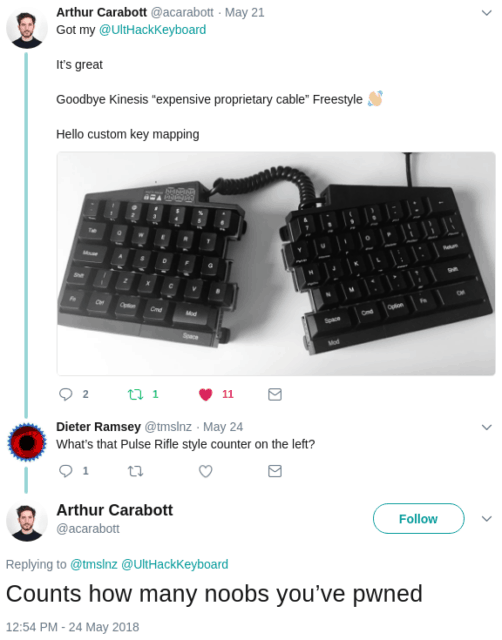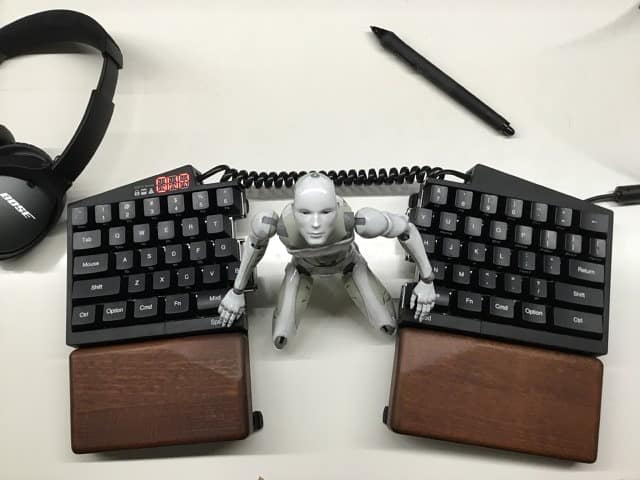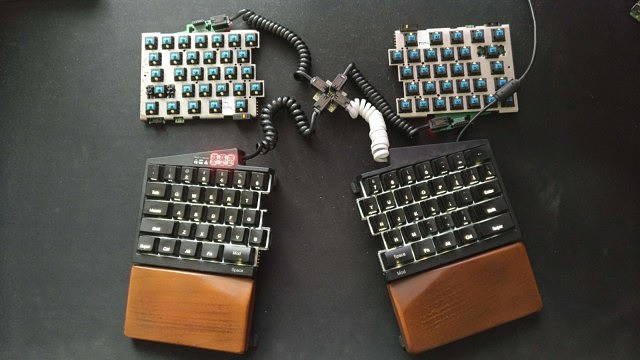Important: Please make sure that your shipping address is up to date! You can change it on your Crowd Supply account page. Please also check out the delivery status page.
Hi there, and welcome to our monthly status update!
TL;DR: Since our last update, we’ve sent out mini batches 5, 6, 7, 8, and 9. This is the highest volume we’ve produced so far, but not as high as we ultimately aim for. We’ve fallen behind with pre-assembly due to the aforementioned staffing issues, but we’re catching up, and the ramp up is still underway. The development of the modules is in progress.
First up, let us share a beautiful and very original picture that we love very much. It’s made by Yukio Miyamoto. He is a masterful illustrator who also happens to be an awesome backer of ours.
Your recent feedback
The feedback you keep giving to us continue to be amazing.
@UltHackKeyboard #GotMyUHK huge thanks to the UHK team. It’s been 3 yrs but the way you strived for quality and the excellent communications to your backers really showed! Fantastic result!! Thank u this is the most exciting piece of HW I have gotten for my PC in the last 5 yrs! pic.twitter.com/0ZF3FxjehY
— Carlos (@carll) June 7, 2018
#GotMyUHK @UltHackKeyboard You guys matched my desk almost perfectly. :) Initial impressions: VERY good.
+ Caps and Switches all feel premium.
+ Agent and the setup was painless and well done.
+ Overall feel is outstanding! Great quality and very solid! pic.twitter.com/p0FYWSP24h— Christopher Brummet (@SwordOfStories) May 30, 2018
The following is an interesting one. Did you know that when armed with a USB OTG cable, you can connect your UHK to your Android phone, and you can probably also control the mouse pointer? (Recent Android kernels tend to support USB mice.)
Typing station. pic.twitter.com/P9OHJhImOi
— Kafka Fuura (P.N.) (@ZephyrRz) June 3, 2018
Lastly, this one made us laugh out loud:

Please keep them coming! We’re excited to hear about y’all.
Module progress
Production does keep us busy, and we can’t yet devote as much time for development as we’d like to, but we’ve made some progress with the modules.
The following is sitting on my desk, and it might just be the weirdest keyboard ever.
But most importantly, this Frankenstein keyboard is a proof of concept! This is 1 UHK right half and 3 left halves interconnected. The top left half simulates a left module, and the top right half (which is a left UHK half) simulates a right module.
The keyboard halves and modules communicate via the main I2C bus of the UHK. The right UHK half is the I2C master which initiates all communication on the bus. The rest of the devices are I2C slaves. From the standpoint of the firmware, there is no difference between the left keyboard half and the modules.
I basically dremeled a protoboard to size, and created a passive 4 port 4P4C hub out of it to interconnect the pieces. Then I added test keymaps for the modules, and reflashed the firmwares of the left module and the right module, so that their I2C addresses don’t clash with the I2C address of the left UHK half.
This proof of concept works as intended, and now I can type on all the 4 keyboard halves, making me seem like I overcompensate for something.
As you can imagine, this is the first step of many to follow. Next up, I will extract the part of the firmware that will be shared across the modules and the left half, and then create separate firmware projects for the modules, utilizing the extracted code.
Then I’ll attach the peripherials specific to the individual modules to these development UHK left halves, and write firmware code to drive them.
In the meantime, András will finalize the plastic cases and mechanical design of the modules, so that they’ll be optimized for manufacturing. This will, in turn, enable me to design the custom PCBs of the modules.
In a way, developing the modules is like developing additional products - 4 products to be exact, and even though we’ve gained a lot of experience, realistically speaking, there’s no way the modules will be ready by the end of August as originally planned.
Given the above, we’re changing the estimated delivery date of the modules to the end of December which should be more realistic. None of us are happy with delays, but we’d much rather take our time than compromise the quality of the product even the slightest bit. According to your feedback, it’s the right thing to do.
Thank you for reading this update! As always, we’ll be keeping you updated on all things UHK, and we’re looking forward to talking with you on 2018-07-12.


8 Responses
You know...a good addon would be a USB hub... just saying. :) But not a critical one, so I'm OK waiting until you guys have some time to brainstorm, haha. I'm really liking my UHK for portable use. It's now my go-to for my 2-in-1 tablet since it can replace the mouse so easily. Any idea what the turn-around for ordering stuff like new cases or keycaps would be right now? Again, just curiosity, no hurries. You are doing awesome!
Hi Fiss, We wish we could create a USB hub module, but unfortunately the bandwidth of the UHK I2C bus is 100kbit which is nothing compared to the bandwidth that USB needs. Very glad to hear you like your UHK! New orders should enter to the end of the queue, so if you order now, it's expected to deliver around the date that you can see at the end of the delivery status page.
Thanks for another update. It's nice to see the project progressing each month, and I'm happy that the first orders went out. I'm eagerly looking forward to next month, when my UHK is set to arrive. :-)
The module delay is a bit unfortunate since I also ordered two of those. However, for me the modules are merely 'icing on the cake'. The real productivity and ergonomic benefit has to come from the UltimateHackingKeyboard itself, with the modules nice extras. So the delay of the modules is no problem and totally understand it.
Good luck with the further progress. It would be cool if the modules are shipped out in December, because that would make 2019 a more calmer year for the UHK team. :-)
Thanks for your understanding, Jos! Yes, we'd like to get things wrapped up by the end of 2018. Excited to deliver your keyboard soon! :)
I'm just curious. Why have you choose a miniusb connection for the connection with the computer? Was there any specific reason to chose it over a microusb, for example?
It's more robust mechanicall according to my experience, although some say otherwise. In any case, we'd like to use USB-C for the next UHK revision.
Fully stoked that my order number shipped in batch 10. Any idea on shipping time to deliver to the U.S.?
Congrats on getting these things out the door.
Exciting times! Generally, it takes about 2-3 days for us to ship to Crowd Supply. From that point on, it should take a couple more days for them to ship to the US. You're welcome to mail them to orders at crowdsupply dot com.